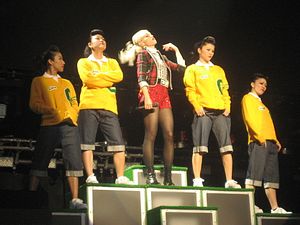Western pop artists appear to be having a difficult time incorporating Eastern history and culture into their acts without coming across as offensive. Since the mid 2000s, historical and cultural aspects of Korea and Japan have been inspiring pop culture in the U.S. From Katy Perry’s geisha outfit at the American Music Awards to Justin Bieber’s unfortunate visit to the Yasakuni Shrine to Gwen Stefani’s Harajuku Girls, America has been increasingly stirred by Asian music, movies, fashion and art, but are the artists crossing the line from appreciation to offensive?
Avril Lavigne stated that her newest music video, “Hello Kitty,” was created to celebrate Japan’s kawaii [cute, similar to Korea’s aegyo] culture and draw her closer to her large Japanese fanbase. However, response to the video was mixed, spurring debates on perceived racist elements. The Twitter reaction ranged from “@_MyMindTalks: how is this racist? People are way too sensitive and really need to stop over dramatizing things” to “@Nubobot42: It’s Almost Impossible to Choose the Most Racist Moment of Avril Lavigne’s New Video.”
While watching Lavigne dance around in a candy store and sushi bar with her four silent backup dancers, you may experience a flashback to Gwen Stefani’s L.A.M.B. Harajuku Girls. The 2004 Love. Angel. Music. Baby. album’s muse was Harajuku culture. (Harajuku is the Tokyo shopping district where the popular trend of layering different styles and colors originated in the middle of last decade.) Stefani’s Harajuku Girls, four Japanese women contractually obligated to only speak Japanese in public while shadowing her on the red carpet and at photo shoots, were renamed by Stefani after her album as Love, Angel, Music and Baby. The foursome acted as her accessories throughout the album’s promotion and tour. Stefani received sharp criticism from journalists and bloggers who declared her vision was a twisted version of the Japanese subculture and exploited racial stereotypes.
Margaret Cho, American comedian and fashion designer, wrote a blog about her feelings on Stefani’s use of the Harajuku Girls, publically declaring it a minstrel show, to which Stefani responded, “the truth is that I basically was saying how great the culture is… the Harajuku Girls is an art project. It’s fun!” Stefani stated that she was surprised by the comments of racism thrown her way, to which blogger Carmen Van Kerckhove responded, “Yeah, gee I wonder why people would view Japanese women as submissive, pliable creatures when Gwen Stefani is parading these four women around as dancing, giggling human props…”
Is Lavigne going down the same slippery slope by playing dress-up, or is she truly embracing Japanese culture? Her response to the negative outcries was, “I love Japanese culture and I spend half of my time in Japan. I flew to Tokyo to shoot this video… specifically for my Japanese fans, WITH my Japanese label, Japanese choreographers AND a Japanese director IN Japan.”
Most negative reactions to Lavigne’s new single have come from Western media, so what are the reactions of those in Asia? On twitter, @IndieRepub states “Funny how the avril lavigne’s hello kitty song is wildly popular in Japan while in the USA, people think it’s racist.” According to @non11chan, “This is NOT Racist. I promise. I’m Japanese! I like this video! <3.” And @CWhite20XX muses, “Has anyone bothered to poll Japan?” No one can deny Lavigne’s popularity in Japan with her last two records selling more albums in Japan than stateside and four of her singles being top 10 hits in Japan, but could this song put a huge dent in her fanbase?
American artists can appreciate and even incorporate K- and J-pop culture without emphasizing Asian stereotypes. Lady Gaga is showing her respect by touring with K-pop girl band Crayon Pop and Hatsune Miku, a holographic Japanese digital pop star, who will be the opening acts of Gaga’s ARTPOP Ball. Other American artists such as girl band School Gyrls collaborated with The Wonder Girls (K-pop) for the hit single, “The DJ is Mine,” and in a made-for-tv movie the Wonder Girls appeared on TeenNick to increase their popularity in the states and also teach Korean culture by explaining phrases like “Dae bak.”
The gentlemen of K-pop are also making a name for themselves stateside. G-Dragon from BIGBANG collaborated with Missy Elliot and EXO’s “Growl” is the fifth bestselling K-pop track in America. But pop stars from Korea and Japan do not need to rely on American artists to be popular in the U.S. Just look at PSY’s hit single “Gangnam Style” and Girls Generation “I Got a Boy,” which beat out Justin Bieber and Lady Gaga for YouTube music video of the year. Not to mention last month when 2NE1 set the new record for highest-charting and bestselling K-pop album at No. 61 out of Billboard’s top 200.
Was Lavigne’s goal in making the video truly to appeal to her Japanese fans and did she achieve that goal respectfully? As global citizens we must take a serious look at pop culture’s translation of worldwide lifestyles and ask, as Darren Franich at Entertainment Weekly does, “serious questions about whether it’s offensive (expressionless Asian dancers, Tokyo-as-prop)… or offensively obvious (this one’s for you, large Japanese fanbase!).”
Clare Hubbard is the Associate Director of Programs & Internship Coordinator at the Korea Economic Institute of America.

































